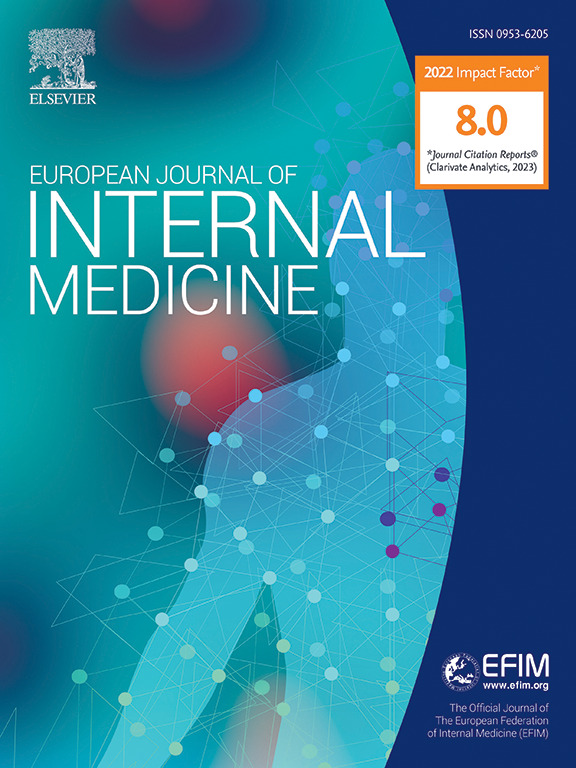重度肥胖患者袖式胃切除术与Roux-en-Y胃旁路治疗后的长期生活质量:来自袖式旁路多中心随机对照试验的结果
IF 6.1
2区 医学
Q1 MEDICINE, GENERAL & INTERNAL
引用次数: 0
摘要
背景:与Roux-en-Y胃旁路相比,袖式胃切除术后的长期生活质量(QoL)结果的信息有限。方法:在一项开放标签随机对照试验中对这些技术进行比较。本文采用36项简短健康调查和EuroQol-5维度3-Level问卷和疾病特异性生活质量(DSQoL),采用Moorehead-Ardelt问卷(专门为肥胖个体设计,评估自尊、身体活动、工作表现、性生活、饮食行为和社会互动)和胃食管反流疾病问卷(GERD-Q),重点研究与健康相关的一般生活质量(HRQoL);胃肠生活质量指数(GIQLI);以及哮喘控制问卷。简单碳水化合物的摄入量通过荷兰甜食调查问卷进行评估。术前、术后2个月及每年随访5年。分析采用线性混合模型。科恩d (CD)效应大小表明小(0∙2)、中(0∙5)和大(0∙8)效应。荷兰审判登记册NTR4741。研究结果:从2013年到2017年,628名患者随机分为袖式胃切除术(n = 312)和Roux-en-Y胃旁路术(n = 316)。最小随访时间为5年(最后一次随访时间为2022年7月29日)。平均年龄43岁[SD, 11]岁;平均BMI 43∙5 [SD, 4∙7]和81∙8%为女性。一般HRQoL无临床相关差异。旁路组2年时Moorehead-Ardelt评分较高(差异0∙4,[95% CI -0∙6至-0∙1],P=。002, CD -0∙3),之后无统计学差异。旁路组的GERD-Q评分在所有时间点均较好,并在5年后保持较高(差异为1∙5,[95% CI 0∙7至2∙3])。结论:对于重度肥胖患者,袖式胃切除术和Roux-en-Y胃旁路术总体上显示出良好的长期HRQoL和DSQoL结果。Roux-en-Y胃旁路术与较少的gerd相关症状相关。在选择手术类型时应考虑反流等因素。本文章由计算机程序翻译,如有差异,请以英文原文为准。
Long-term quality of life after sleeve gastrectomy vs Roux-en-Y Gastric Bypass in patients with severe obesity: Results from the SleeveBypass multicentre randomised controlled trial
Background
Limited information is available on long-term quality of life (QoL) outcomes after sleeve gastrectomy compared to Roux-en-Y gastric bypass.
Methods
These techniques were compared in an open-label randomised controlled trial. This paper focuses on generic health-related QoL (HRQoL) using the 36-Item Short Form Health Survey and EuroQol-5 Dimension 3-Level questionnaires and disease-specific QoL (DSQoL), using the Moorehead-Ardelt questionnaire (specifically designed for individuals with obesity to assesses self-esteem, physical activity, work performance, sexual life, eating behaviour, and social interactions)the Gastroesophageal Reflux Disease Questionnaire (GERD-Q); the Gastrointestinal Quality of Life Index (GIQLI); and the Asthma Control Questionnaire. Simple carbohydrate consumption was assessed with the Dutch Sweet Eating Questionnaire. Measurements were taken preoperatively, 2 months post-surgery, and annually up to 5 years. Analyses used a linear mixed model. Cohen's d (CD) effect sizes indicate small (0∙2), medium (0∙5), and large (0∙8) effects. Dutch Trial Register NTR4741.
Findings
From 2013 until 2017, 628 patients were randomised between sleeve gastrectomy (n = 312) and Roux-en-Y gastric bypass (n = 316). Minimal follow-up was 5 years (last follow-up July 29th, 2022). Mean age was 43 [SD, 11] years; mean BMI 43∙5 [SD, 4∙7] and 81∙8 % were women. No clinically relevant differences in generic HRQoL were observed. Moorehead-Ardelt scored higher in the bypass group at 2 years (difference 0∙4, [95 % CI -0∙6 to -0∙1], P=.002, CD -0∙3), without statistically differences later on. GERD-Q scores were consistently better in the bypass group at all time points and remained higher after 5 years (difference 1∙5, [95 % CI 0∙7 to 2∙3], P<.001, CD 0∙3). GIQLI showed a statistically significant better outcome in the bypass group after 4 and 5 years (difference -4∙6, [95 % CI -8∙7 to -0∙4], P = 0.032, CD -0∙17). Sweet-eating showed no statistically significant differences over time.
Conclusion
For patients living with severe obesity, sleeve gastrectomy and Roux-en-Y gastric bypass overall showed good long-term HRQoL and DSQoL outcomes. Roux-en-Y gastric bypass was associated with less GERD-related symptoms. Factors such as GERD should be considered when choosing the type of surgery.
求助全文
通过发布文献求助,成功后即可免费获取论文全文。
去求助
来源期刊
CiteScore
9.60
自引率
6.20%
发文量
364
审稿时长
20 days
期刊介绍:
The European Journal of Internal Medicine serves as the official journal of the European Federation of Internal Medicine and is the primary scientific reference for European academic and non-academic internists. It is dedicated to advancing science and practice in internal medicine across Europe. The journal publishes original articles, editorials, reviews, internal medicine flashcards, and other relevant information in the field. Both translational medicine and clinical studies are emphasized. EJIM aspires to be a leading platform for excellent clinical studies, with a focus on enhancing the quality of healthcare in European hospitals.

 求助内容:
求助内容: 应助结果提醒方式:
应助结果提醒方式:


